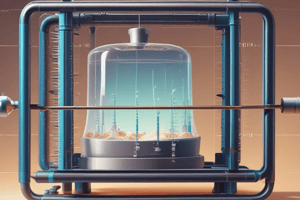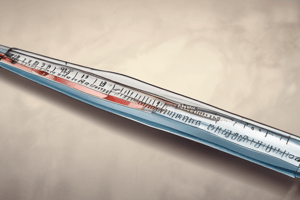Podcast
Questions and Answers
What is the primary principle behind the functioning of mercury-in-glass thermometers?
What is the primary principle behind the functioning of mercury-in-glass thermometers?
- Radiation of heat from the mercury
- Expansion of mercury with temperature (correct)
- Convection of heat through the air
- Conduction of heat through the glass
Which of the following heat transfer modes involves the direct transfer of heat between particles in physical contact?
Which of the following heat transfer modes involves the direct transfer of heat between particles in physical contact?
- Convection
- Radiation
- Conduction (correct)
- Thermometry
What is the equation that describes heat conduction?
What is the equation that describes heat conduction?
- Q = σ * A * T^4
- Q = -k * A * (dT/dx) (correct)
- Q = h * A * (T_s - T_f)
- Q = m * c * ΔT
Which temperature scale has an absolute zero point?
Which temperature scale has an absolute zero point?
Which of the following thermometers measures temperature using infrared radiation?
Which of the following thermometers measures temperature using infrared radiation?
What is the temperature at which water boils in the Fahrenheit scale?
What is the temperature at which water boils in the Fahrenheit scale?
What is the formula to convert Celsius to Fahrenheit?
What is the formula to convert Celsius to Fahrenheit?
Which of the following heat transfer modes involves the movement of fluids?
Which of the following heat transfer modes involves the movement of fluids?
Flashcards are hidden until you start studying
Study Notes
Thermometry
- Definition: Thermometry is the science of measuring temperature.
- Thermometers: Devices used to measure temperature, typically consisting of a temperature sensor and a display.
- Types of Thermometers:
- Mercury-in-glass thermometers: Use expansion of mercury to measure temperature.
- Digital thermometers: Use electronic sensors and display temperature digitally.
- Infrared thermometers: Measure temperature using infrared radiation.
- Thermocouples: Measure temperature using the Seebeck effect (voltage generated by temperature difference).
Heat Transfer
- Definition: Heat transfer is the transfer of thermal energy from one body to another due to a temperature difference.
- Modes of Heat Transfer:
- Conduction: Direct transfer of heat between particles in physical contact.
- Convection: Heat transfer through the movement of fluids (e.g., air, water).
- Radiation: Heat transfer through electromagnetic waves (e.g., light, radio waves).
- Heat Transfer Equations:
- Fourier's Law: Describes heat conduction (Q = -k * A * (dT/dx)).
- Newtons Law of Cooling: Describes heat convection (Q = h * A * (T_s - T_f)).
Temperature Scales
- Definition: Temperature scales are systems for measuring temperature, each with its own zero point and unit of measurement.
- Common Temperature Scales:
- Celsius (°C) Scale:
- Water freezes at 0°C.
- Water boils at 100°C.
- Fahrenheit (°F) Scale:
- Water freezes at 32°F.
- Water boils at 212°F.
- Kelvin (K) Scale:
- Absolute zero (0 K) is the theoretical minimum temperature.
- Water freezes at 273.15 K.
- Water boils at 373.15 K.
- Celsius (°C) Scale:
- Temperature Conversion: °F = (°C × 9/5) + 32 °C = (°F - 32) × 5/9 K = °C + 273.15
Thermometry
- Thermometry is the science of measuring temperature.
- Thermometers are devices used to measure temperature, consisting of a temperature sensor and a display.
Types of Thermometers
- Mercury-in-glass thermometers use expansion of mercury to measure temperature.
- Digital thermometers use electronic sensors and display temperature digitally.
- Infrared thermometers measure temperature using infrared radiation.
- Thermocouples measure temperature using the Seebeck effect (voltage generated by temperature difference).
Heat Transfer
- Heat transfer is the transfer of thermal energy from one body to another due to a temperature difference.
Modes of Heat Transfer
- Conduction is the direct transfer of heat between particles in physical contact.
- Convection is heat transfer through the movement of fluids (e.g., air, water).
- Radiation is heat transfer through electromagnetic waves (e.g., light, radio waves).
Heat Transfer Equations
- Fourier's Law describes heat conduction: Q = -k * A * (dT/dx).
- Newton's Law of Cooling describes heat convection: Q = h * A * (T_s - T_f).
Temperature Scales
- Temperature scales are systems for measuring temperature, each with its own zero point and unit of measurement.
Common Temperature Scales
- Celsius (°C) Scale:
- Water freezes at 0°C.
- Water boils at 100°C.
- Fahrenheit (°F) Scale:
- Water freezes at 32°F.
- Water boils at 212°F.
- Kelvin (K) Scale:
- Absolute zero (0 K) is the theoretical minimum temperature.
- Water freezes at 273.15 K.
- Water boils at 373.15 K.
Temperature Conversion
- °F = (°C × 9/5) + 32
- °C = (°F - 32) × 5/9
- K = °C + 273.15
Studying That Suits You
Use AI to generate personalized quizzes and flashcards to suit your learning preferences.




